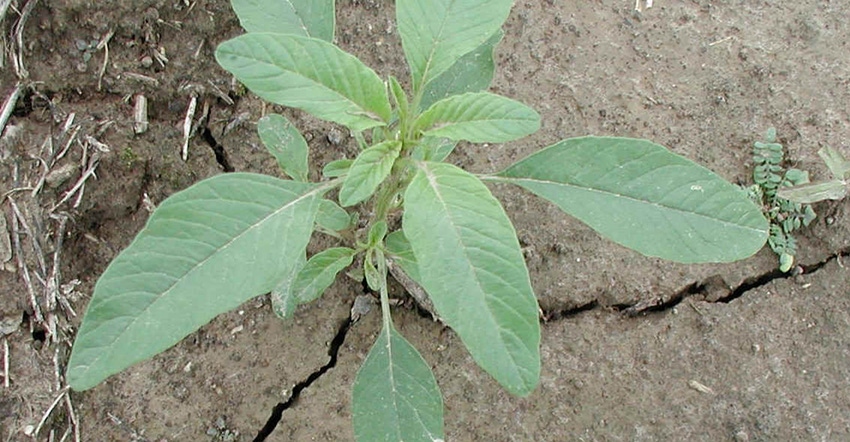
There are three types of farms — those that have waterhemp, those that will have it and those that already have it but just don’t know it yet, says Bill Johnson, Purdue University Extension weed control specialist.
This member of the pigweed family is especially difficult to control once it gets established because most populations have resistance to two or more herbicide chemistries, notes Johnson. Nevertheless, you can control waterhemp in soybeans if you put together a smart weed control plan, he says.
Here are 10 tips for putting together a sound strategy. For more information, read "Waterhemp Management in Soybeans" in the 2017 Ohio, Indiana and Illinois Weed Control Guide prepared by Johnson, Mark Loux at Ohio State University and Aaron Hager at the University of Illinois. Access it online at estore.osu-extension.org. Get more specific information about waterhemp control at takeactiononweeds.com.
1. Apply effective residual herbicides before or soon after planting. Residual herbicides prevent early-season interference with the crop. Plus, if you’re applying PPO inhibitors (Group 14) or glyphosate (Group 9) postemergence and the population is resistant to both, you won’t get control.
2. Choose an effective soil-applied herbicide. Your final choice will depend somewhat on what you know about herbicide resistance in the field. Residual choices include: Authority First, Authority Assist, Authority MTZ, Authority XL, Boundary, Dual II Magnum or other metolachlor products, Enlite, Envive, Fierce, Gangster, Outlook, Prefix, Sencor, Sonic, Treflan, Valor, Valor XLT, Warrant and Zidua.
3. Use full rates of residual herbicides. Waterhemp continues germinating during the season. If you cut the herbicide rate, there may not be enough active ingredient left later in the season.
4. Know resistance levels. You know waterhemp is resistant to Group 9 (glyphosate) but not Group 14. You can apply PPO inhibitors like Cobra, Flexstar, Phoenix or Ultra Blazer. Waterhemp plants must not be more than 3 to 4 inches tall.
5. Consider still applying glyphosate in Roundup Ready beans. Even if waterhemp is resistant to glyphosate, you may apply it in combination with Group 14 herbicides. You may need glyphosate to pick up other weeds.
6. Get weeds while they’re small. If you’re applying a Hroup 14 herbicide like Cobra, Flexstar, Phoenix or Ultra Blazer, weed size is critical. Group 14 herbicides are most effective against waterhemp plants that are 4 inches or smaller. A 4-inch weed is a pretty small weed, Johnson notes.
7. Apply adequate total spray volume per acre. If you’re applying Group 14 herbicides over a dense canopy of weeds and crop, 15 gallons per acre of total spray volume is the minimum, Johnson says. A volume of 20 to 40 gallons per acre is better to ensure good coverage.
8. Be aware of special note if Prefix is applied. Where Prefix is used preemergence, the label doesn’t allow application of Flexstar or any fomesafen product after emergence.
9. Consider adding overlapping residuals to postemergence application. Effective choices include but aren’t limited to these Group 15 products: Anthem, Cinch, Dual II Magnum, Outlook, Prefix, Warrant and Zidua.
10. Understand residuals and weed size are crucial in LibertyLink system. Applying an effective soil-residual herbicide preemergence is critical, Johnson says. It’s also crucial to apply glufosinate when waterhemp is no more than 3 to 4 inches tall.
About the Author(s)
You May Also Like




